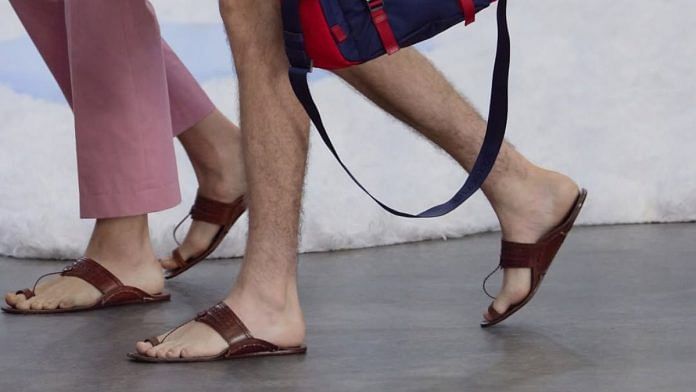Guess what has strutted from the gullies of Kolhapur to the international runway? The Kolhapuri chappals. They’re the latest addition to a long list of elements from Indian culture ‘rebranded’ by the West, such as chintz, cummerbunds, Nehru jackets, turbans, Scandi scarves, and the mandi bag.
Yes, Kolhapur just went couture. And it’s frustrating—even infuriating—to watch luxury foreign brands swoop in, pick elements of our fashion heritage, slap their label on it, and suddenly, it’s worth thousands of dollars.
What’s worse, we fall for it.
Why do we need a foreign label to validate what we have been mastering for centuries? It’s time we stop letting the West sell our heritage back to us in prettier packaging.
At Milan Fashion Week, Prada showcased its Spring/Summer 2026 menswear collection. Titled ‘A Change of Tone’, the collection marked a shift from power dressing to a softer, introspective tone.
But among the holiday-ready footwear like loafers and flip-flops, were pairs of leather Kolhapuri chappals.
On the runway, the Kolhapuris were styled with shorts, track pants, and polo-neck knits. And, to go by the buzz, a pair will cost around £1,000 (over Rs 1 lakh).
Meanwhile, in India, Kolhapuri chappals are available at a humble price of Rs 800-900 (even lower, if you are good at bargaining).
Also read: ‘Stop working with Diljit’—Sardaar Ji 3 faces boycott call. AICWA opposes Hania Aamir
West ‘discovers’ Kolhapuri
Kolhapuri chappals have been a part of Indian footwear tradition for over 800 years. They have their origins rooted in the 12th century during the rule of King Bijjala and his minister Basavanna in Kolhapur.
Now suddenly, Kolhapuri chappals are the next big fashion moment, all because Europeans have ‘discovered’ them and decided they’re trendy. Indian culture is getting a global stage, but are the artists benefiting from it?
Craftsmen in India struggle for recognition and fair wages, but Western brands profit off their work by rebranding it as high fashion. It’s not just cultural appropriation, it’s a slap in the face of the people who create these pieces.
Meanwhile, here we are—still busy drooling over Louis Vuitton, Gucci, and whatever foreign label drops the next overpriced tote.
Let’s not pretend we need Prada to show us how to “elevate” Kolhapuris or handloom.
Strip away the fancy branding, and what you’re left with is this: Indian heritage, repackaged as high fashion, just because someone with a foreign accent said it’s chic.
But the truth is, it’s ours: our design, our skill, our story.
If we don’t tell our story, someone else—clearly—will.
Views are personal.
(Edited by Prasanna Bachchhav)







Fashion houses across the world are filled with morons of the first order.